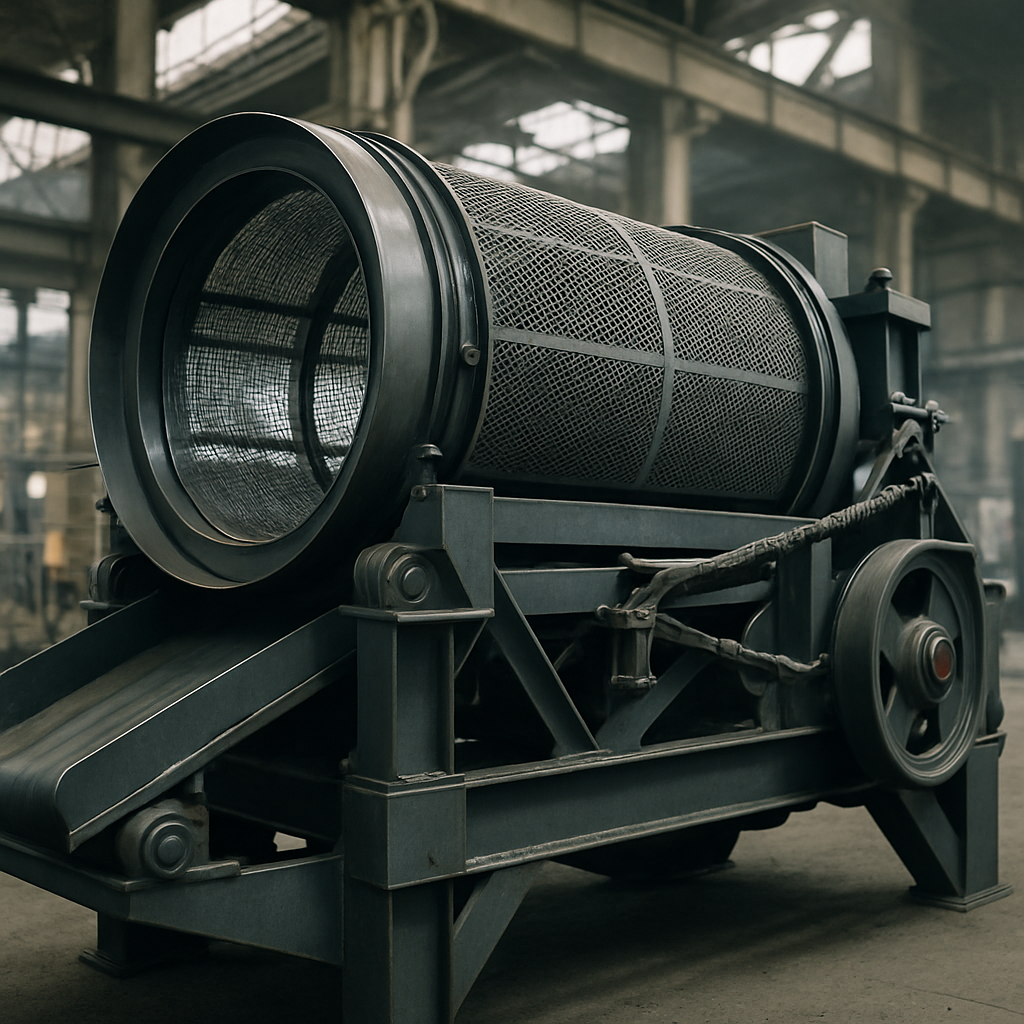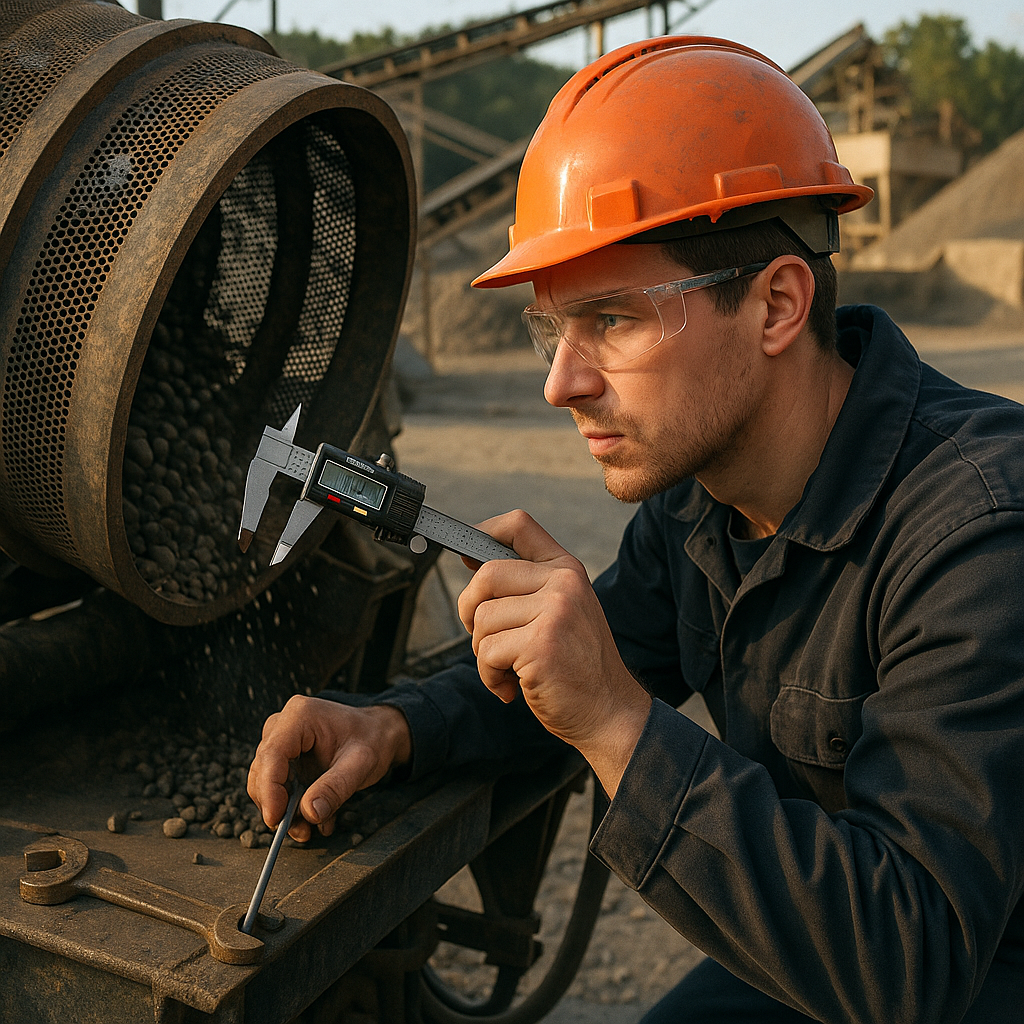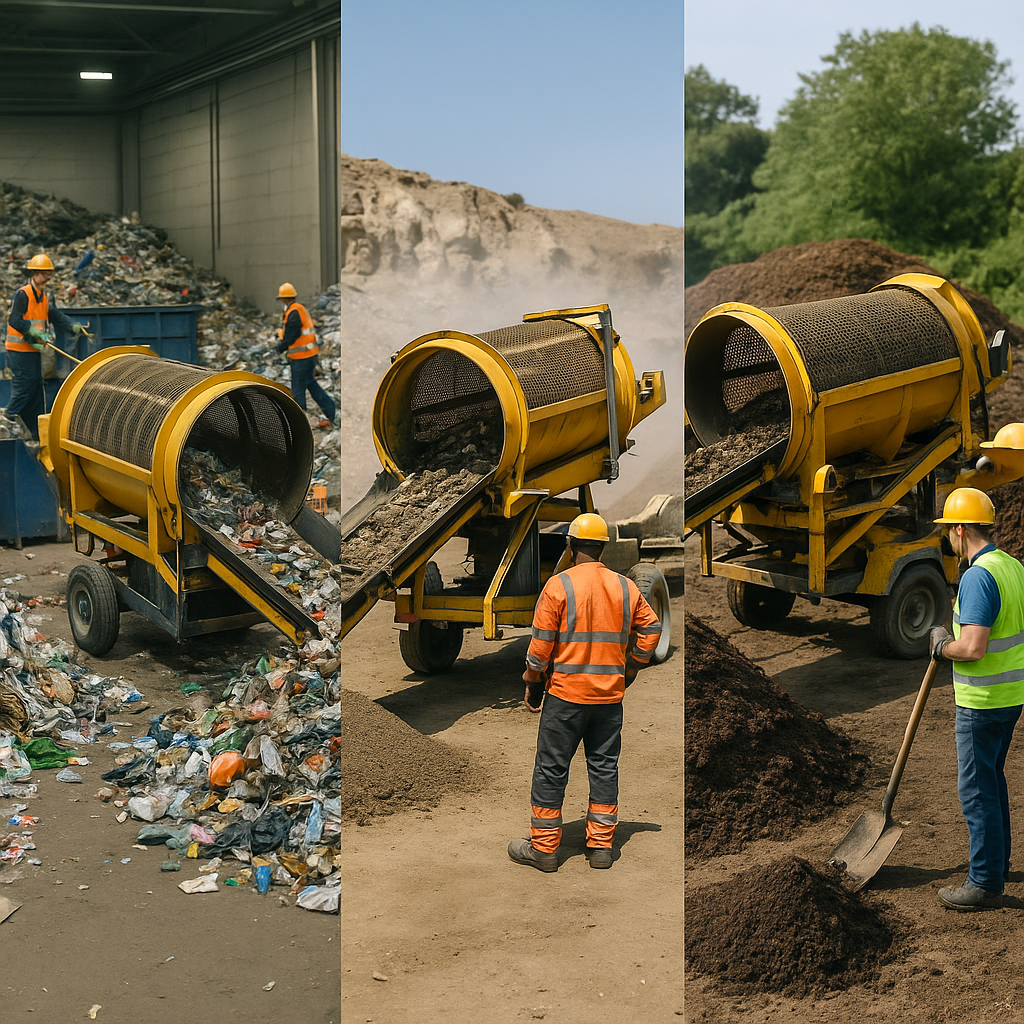5901 Botham Jean Blvd, Dallas, TX 75215
Metal Seperation in Recycling: Learn What Trommel Screen is and How it Works
October 15, 2025A trommel screen is a specialized mechanical device that enhances material separation in recycling and waste management industries. This cylindrical workhorse, also known as a rotary screen, efficiently sorts materials by size through a simple yet effective process. The system features a perforated drum mounted at a slight angle, allowing for precise material classification.
The operation relies on basic physics. As the cylindrical drum rotates, materials enter through the elevated end and begin a controlled spiral descent. This rotational movement creates a tumbling effect crucial to the separation process. Smaller particles that match the screen openings fall through the perforations, while oversized materials continue to exit at the lower end of the drum. The outcome is a clean separation based entirely on particle size.
The trommel screen’s effectiveness lies in its ability to handle materials that challenge other screening methods. Its rotating action prevents clogging while providing continuous screening capabilities, making it particularly valuable for processing compost, municipal waste, and aggregate materials where efficiency and reliable separation are essential.
What are the Key Components of a Trommel Screen?

Trommel screens are vital in the recycling industry, separating materials by size through a rotating mechanism. Each component plays a specific role in efficiently processing recyclable materials. Let’s explore the critical elements that make these recycling workhorses so effective.
The Rotating Drum: The Heart of the System
The cylindrical drum is the core of any trommel screen. Constructed from durable materials like reinforced mild steel, it rotates on a horizontal axis, allowing materials to tumble as they move through the system. The drum’s size directly influences its processing capacity, with larger drums handling more recyclable materials.
Screen Panels and Mesh: Material Sorting Interface
Attached to the drum, screen panels or mesh form the sorting mechanism. These panels have precisely sized openings that let smaller materials fall through while larger items continue along the drum. Two common configurations include:
- Perforated plate screens: Offer superior strength and durability with fewer ridges, making cleaning easier
- Mesh screens: Easier to replace but require more intensive cleaning as materials can become wedged in the mesh ridges
The aperture shape and size can be tailored to specific recycling applications, with round or square openings being the most common.
Motor and Gearbox: Power System
The motor and gearbox assembly provides the rotational force needed to turn the drum. This system allows for adjustable rotation speeds, significantly influencing sorting efficiency. A properly set rotation speed ensures optimal material agitation without causing excessive wear. Power requirements vary based on drum size and material density.
Support Structure: Stability Framework
The support structure holds the entire system’s weight while maintaining proper alignment during operation. Most designs include:
- Heavy-duty steel framework
- Support wheels or rollers to facilitate drum rotation
- Mounting points for proper drum inclination
- Vibration-dampening elements to reduce operational noise
The structure is usually elevated slightly (2-5 degrees) to aid material movement through the system.
Inlet and Outlet Points: Material Flow Controls
The feed hopper at the inlet directs incoming material into the drum in a controlled manner. Material exits via two main pathways: undersized material falls through screen perforations, while oversized material continues through the drum to the discharge end. This dual-output system facilitates instant material classification by size.
Specialized Internal Components
Several optional internal components can enhance material movement and screening efficiency:
- Lifting bars: Internal ridges that help elevate and tumble material as the drum rotates, preventing material from sliding along the bottom
- Augers or spiral flights: Internal screw mechanisms that help propel material through flatter drum setups, especially when the angle is less than 5 degrees
- Cleaning brushes: External components that prevent screen clogging by continuously clearing apertures during operation
| Component | Function |
| Rotating Drum | Allows materials to tumble for size separation. Directly affects throughput capacity by its size. |
| Screen Panels and Mesh | Sort materials through their openings by size. Configurations include perforated plates and mesh screens. |
| Motor and Gearbox | Provide necessary rotational force and allow for adjustable speeds to enhance sorting efficiency. |
| Support Structure | Maintains system alignment, bears weight, and features vibration-dampening elements. |
| Inlet and Outlet Points | Controls material flow into and out of the drum for efficient sorting. |
| Lifting Bars & Spiral Flights | Enhance material movement within the drum. |
Additional Support Systems
Several support systems often complement the main components of a trommel screen:
- Conveyor systems for material feeding and collection
- Dust suppression systems, often utilizing water jets
- Control panels for adjusting operational parameters
- Maintenance access points for servicing internal components
Integrating these components creates an efficient sorting system, customizable for various waste streams. For recycling facilities, adjusting screen apertures and drum rotation speeds allows versatility in processing different materials, making trommel screens indispensable in modern waste management operations.
What Factors Affect Trommel Screen Efficiency?

The efficiency of a trommel screen depends on several interconnected factors that must be balanced to achieve optimal material separation. Proper adjustment ensures these factors work together for maximum throughput while maintaining product quality in recycling and waste management operations.
Rotational velocity directly impacts how material moves through the drum. At low speeds, material tends to slump, resulting in lower screening efficiency as only smaller particles near the drum wall get properly screened. At optimal speeds, material follows a cataracting motion where it is lifted and dropped repeatedly, allowing smaller particles to reach the screen surface while larger ones remain inside. However, excessive speeds cause centrifuging, where material sticks to the drum wall due to centrifugal forces, significantly reducing separation efficiency.
The mass flow (feed rate) of material entering the trommel is also crucial. Lower feed rates often yield higher screening efficiency because particles have more opportunities to contact the screen surface. As feed rates increase, the thickness of material in the drum grows, making it harder for smaller particles to reach and pass through the screen openings. Balancing throughput and separation quality is essential for operational productivity.
Drum design characteristics significantly affect performance:
- Drum size (diameter and length) determines the available screening area and residence time
- Inclination angle influences material flow speed through the drum – higher angles increase production rates but may reduce efficiency
- Number and size of screen openings affect how much material can pass through
- Screen aperture shape (round vs. square) impacts both throughput and cleaning requirements
Material characteristics present some of the most challenging variables. Moisture content is particularly influential – excessive moisture creates sticky material that adheres to the drum or blocks openings. Density affects power requirements and processing time, while material composition can impact wear patterns and maintenance needs. Even particle size distribution in the incoming material stream affects how efficiently separation occurs.
The drum’s internal components also play a role. Lifter bars or internal screws help agitate material, break up clumps, and move content through the drum. These components provide the critical lifting and dropping action that exposes more material to screen openings.
Optimizing trommel screen efficiency requires careful consideration of these factors in relation to specific material and production goals. For recycling operations, finding the right balance between throughput and separation quality often means making regular adjustments based on incoming material conditions.
| Motion Type | Description | Impact on Efficiency |
| Slumping | Low speed; particles lifted slightly then tumble. | Lower screening efficiency as only smaller particles near the drum wall are screened. |
| Cataracting | Moderate speed; particles detach and fall near the top of the drum. | Higher screening efficiency due to more exposure to screen surface. |
| Centrifuging | High speed; particles stick to the wall due to centrifugal forces. | Lower screening efficiency as particles do not pass through the screen. |
What are the Applications of Trommel Screens?

Trommel screens serve as dependable workhorses across multiple industries due to their excellent ability to separate materials by size. Their rotating cylindrical design provides an effective sorting mechanism, handling diverse materials with remarkable versatility.
Waste Management and Recycling
In municipal solid waste facilities, trommel screens perform essential separation functions. They efficiently sort commingled recyclables from general waste streams, diverting up to 65% of materials from landfills.
These machines separate domestic waste into different size fractions. Smaller particles typically contain organic materials that can be further processed, while larger materials often include recyclable components like paper, plastic, and metals.
Recovery facilities use trommel screens to remove compostable paper from contaminants like glass in previously shredded waste. Some specialized models are designed to pass paper through while diverting heavier materials for re-crushing or disposal.
Mining and Mineral Processing
The mining industry utilizes trommel screens to separate valuable minerals such as gold, iron ore, and coal from waste rock. This process reduces processing costs and increases output quality.
Mining operations benefit from trommel screens’ ability to handle wet materials. Some models include high-pressure water jets that help break apart large lumps of clay and mud containing valuable minerals.
The tumbling action inside the drum creates an ideal setting for separating denser materials from lighter ones, making trommels particularly effective for mineral recovery operations where material density varies.
Composting and Agricultural Applications
Trommel screens enhance the market value of finished compost by separating large particles and non-degraded bulking agents from organic fines. The screening process removes debris like sticks and rocks from topsoil.
In agricultural settings, these machines create uniform compost products rich in nutrients for plant growth. The fine particle size allows water to drain properly, preventing root rot that can damage crops.
Significantly, trommel screens allow operators to recover and reuse bulking agents like wood chips, contributing to sustainable composting with reduced material waste.
Construction and Aggregate Processing
Construction and demolition waste recycling operations use trommel screens to separate wood, concrete, and asphalt. This practice reduces landfill waste while creating reusable building materials.
Trommels effectively screen soil and aggregates for various construction projects. They grade materials like gravel and sand to ensure they meet specific size requirements for building applications.
The construction industry particularly values the mobility of many trommel screen models, allowing for easy transport between job sites where screening needs frequently change.
Environmental Remediation
Environmental cleanup projects use trommel screens to separate contaminated soil from debris. The separation process facilitates more effective treatment of contaminated materials.
When processing contaminated soils, trommels can incorporate water spray systems that suppress dust, thus meeting health and safety requirements while protecting workers and the environment.
The ability to adjust drum speeds and screen sizes makes these machines adaptable to different remediation scenarios, whether dealing with light contamination or heavily polluted industrial sites.
| Industry | Application | Benefits |
|---|---|---|
| Recycling and Waste Management | Separation of commingled recyclables, compostable paper, and contaminants | Increased landfill diversion, improved recycling efficiency |
| Mining and Mineral Processing | Separation of minerals like gold, iron ore, and coal from waste rock | Reduced processing costs, increased output quality |
| Composting and Agriculture | Separation of organic fines from large particles in compost | Enhanced market value of compost, sustainable reuse of materials |
| Construction and Aggregate Processing | Separation of wood, concrete, asphalt, soil, and aggregates | Reduced landfill waste, graded materials for construction projects |
| Environmental Remediation | Separation of contaminated soils from debris | Facilitates effective treatment, adaptability to different scenarios |
Conclusion: The Value of Trommel Screen Separation

Trommel screens offer an efficient and versatile solution for material separation across various industries. Their rotating drum design provides superior screening capability that prevents blockages and reduces screen blinding, making them ideal for processing sticky, moist, or irregular materials. With customizable drum sizes, adjustable angles, and various screen options, these systems deliver consistent sizing while maximizing resource recovery.
From waste management to recycling, mining, composting, and construction, the applications of trommel screens demonstrate their value in improving operational efficiency. Incorporating this technology into your material processing operations can lead to higher product quality, reduced waste, and enhanced sustainability efforts. For expert assistance with your recycling and material separation needs, contact Okon Recycling at 214-717-4083.
